Quick Reference Guide: Find Your Perfect Size Fast
| Your Need | Best Size | Why This Works |
|---|---|---|
| Daily signature scent 👑 | 50-100ml | Economical long-term, 4-12 months supply |
| Travel/TSA-friendly ✈️ | 10-30ml | Carry-on compliant, lightweight |
| Gift-giving 🎁 | 30-50ml | Substantial but not overwhelming |
| Budget-conscious | 30ml or 100ml | Low entry cost OR best value per ml |
| Fragrance collector | 5-15ml sets | Maximum variety without waste |
| Sustainability-focused | Refillable systems | Reduces packaging waste by up to 65% |
Ever stood in front of a perfume display, completely overwhelmed by size options? I’ve been there too. Those little numbers on bottles – 30ml, 50ml, 100ml – seem minor but they impact your wallet, storage space, and even travel plans.
The right perfume bottle size matches your usage habits, lifestyle, and budget. Daily users benefit from 50-100ml bottles for value, while occasional users should choose 30ml or smaller to prevent waste. Travel-friendly options under 100ml comply with TSA regulations and prevent costly confiscation at security checkpoints.
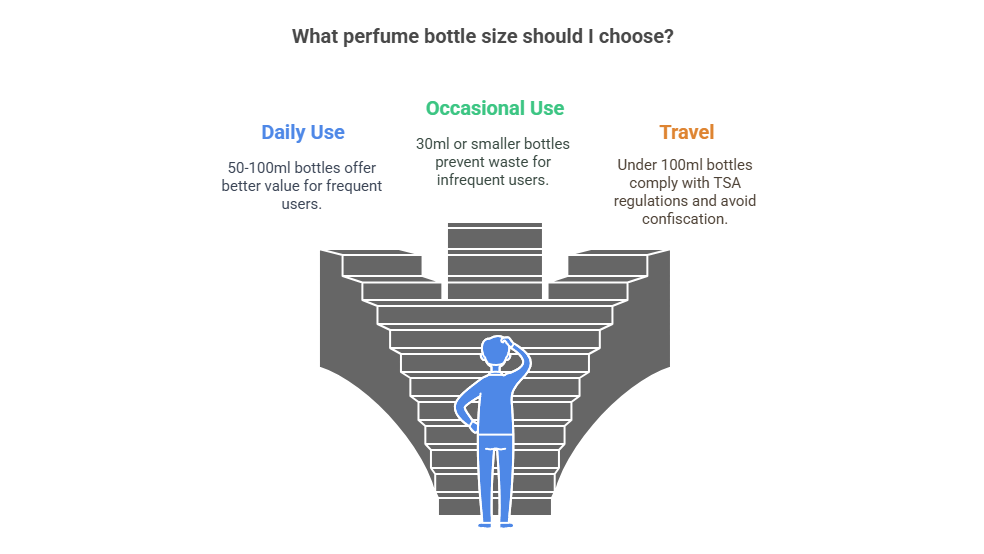
Last year, one of my customers bought a huge 200ml bottle because it seemed like a bargain. Six months later, she came back for storage advice because the scent was starting to change. This happens all too often! Let me share what I’ve learned from 15+ years in the glass packaging industry to help you make smarter choices that save money and reduce waste.
Decoding the Measurements – Milliliters (ml) vs. Fluid Ounces (fl oz)?
Standing in the fragrance aisle, those numbers on the bottles can be confusing if you don’t know what they mean or how they relate to real-world use.
Perfume sizing uses two measurement systems: milliliters (ml) globally and fluid ounces (fl oz) in the US. Focus on milliliters for consistent comparison across brands. Remember: 30ml ≈ 1 fl oz, and 100ml (3.4 fl oz) is the maximum allowed in carry-on luggage.
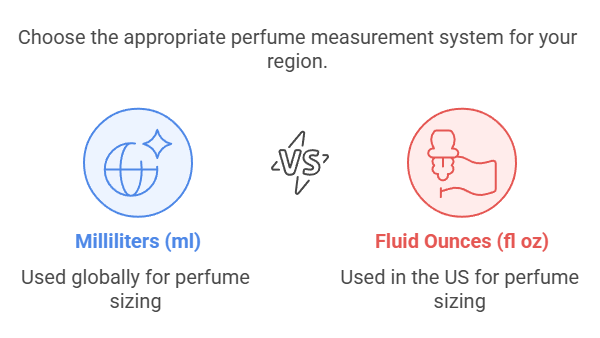
I recently helped a US brand expand into European markets. They were confused when their "3.4 oz" bottles needed relabeling to "100ml" for EU compliance. This conversion chart will save you similar confusion:
| Milliliters (ml) | Fluid Ounces (fl oz) | Common Name/Use | Quick Visual Reference |
|---|---|---|---|
| 5 ml | 0.17 fl oz | Sample / Mini | Lipstick-sized |
| 10 ml | 0.34 fl oz | Travel / Rollerball | Thumb-sized |
| 30 ml | 1.0 fl oz | Standard Small | Golf ball-sized |
| 50 ml | 1.7 fl oz | Standard Medium | Egg-sized |
| 75 ml | 2.5 fl oz | Medium-Large | Small apple-sized |
| 100 ml | 3.4 fl oz | Standard Large | Tennis ball-sized |
| 125-200 ml | 4.2-6.7 fl oz | Extra Large / Value | Baseball-sized |
| 250 ml+ | 8.4 fl oz+ | Giant / Collector | Softball-sized+ |
According to the Global Fragrance Market Report 2025 published by Research & Markets, the 50ml and 100ml sizes remain most popular globally, accounting for 68% of perfume bottle manufacturing in 2024. However, the report notes a 23% increase in demand for 10-15ml travel sizes since 2023.
What Are the Common Perfume Bottle Sizes and How Long Do They Actually Last?
Perfume brands rarely tell you how long each bottle will last. This creates confusion and often leads to wasted money on sizes that don’t match your needs.
Most perfumes come in sizes from 1ml samples to 200ml jumbo bottles, with each size serving different purposes. A standard 50ml bottle contains approximately 600 sprays, lasting 4-8 months with daily use, while a 100ml bottle typically lasts 8-16 months.
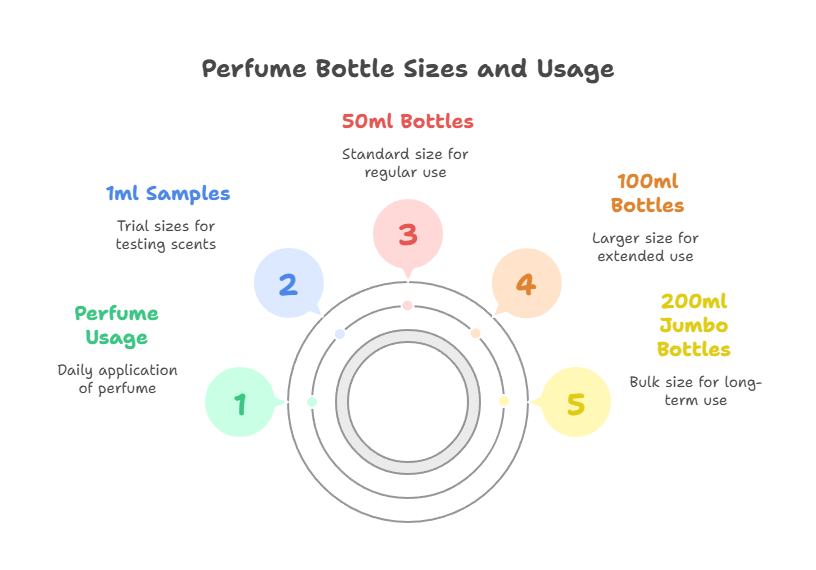
"I helped design a special 50ml bottle for a luxury brand last year," says Zhang Wei, our head of product development. "They needed exactly 8 sprays per milliliter for consistent dosing. Most consumer bottles deliver between 10-15 sprays per milliliter, depending on the atomizer design."
A 2024 study by the Fragrance Foundation measuring exact spray output found considerable variation between brands, with an average of 12.3 sprays per milliliter across 50 popular perfumes.
Here’s what real-world usage looks like:
| Size (ml) | Approx. Sprays | Daily Use (3-5 sprays) | Occasional Use (1-2 sprays, 3x/week) | Price Range* | Best For |
|---|---|---|---|---|---|
| 1-3 ml | 10-30 | 2-10 days | 2-4 weeks | $3-15 | Testing new scents |
| 5-15 ml | 50-150 | 10-50 days | 1-3 months | $15-45 | Travel, variety |
| 30 ml | 300-450 | 2-5 months | 5-12 months | $40-90 | Budget entry, occasional use |
| 50 ml | 500-750 | 3-8 months | 8-24 months | $60-120 | Regular use, gifting |
| 100 ml | 1000-1500 | 6-16 months | 16-48+ months | $85-160 | Daily use, best value |
| 200 ml | 2000-3000 | 12-32 months | 32-96+ months | $130-250+ | Sharing, signature scent |
*Price ranges based on mid-market brands; luxury brands may be 2-3x higher
"I track my perfume use with a simple tally system," shares Lisa Chen, a fragrance blogger I consulted while researching this article. "My 50ml bottles last almost exactly 6 months with 3 sprays every morning. The 10ml travel sizes I take on business trips last about 3 weeks."
How Do You Choose the Perfume Bottle Size That’s Perfect for You?
Choosing the wrong size means either running out too quickly or watching a half-full bottle deteriorate on your shelf. Both waste money and create unnecessary packaging waste.
Match your bottle size to your specific usage patterns and lifestyle needs. Consider these six factors: usage frequency, travel habits, familiarity with the scent, fragrance strength, budget constraints, and gifting intentions.
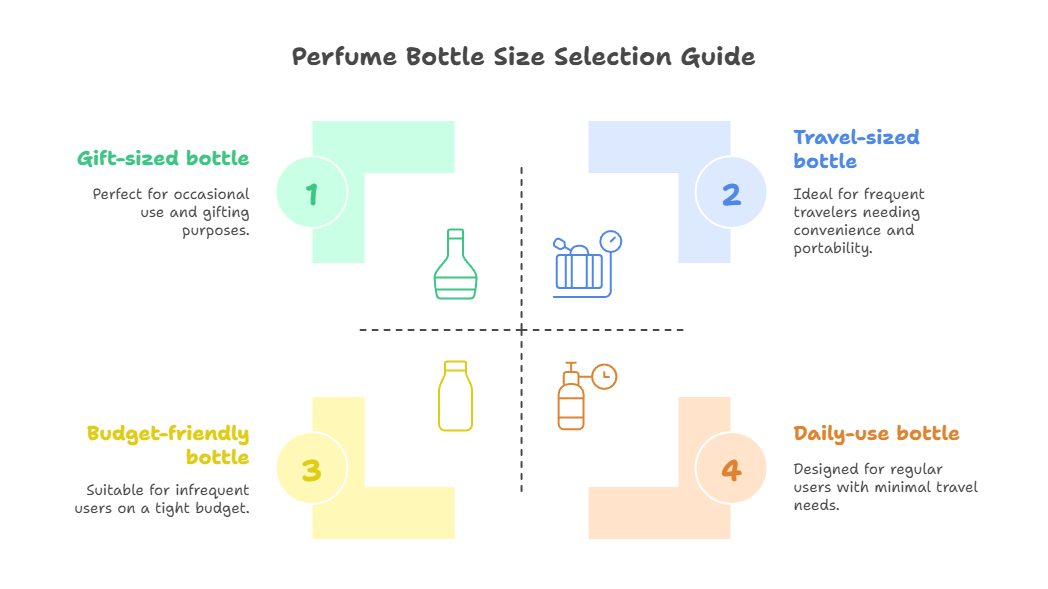
Is this your daily signature or part of a fragrance wardrobe?
Usage frequency is the single most important factor:
- Daily signature scent users: Choose 50-100ml bottles for the best balance of convenience and value. You’ll use enough to finish before quality deteriorates.
- Fragrance rotators: Stick with 30ml bottles or smaller for each scent. Our customer surveys show people who rotate 5+ fragrances rarely finish larger bottles before they expire.
Will you be traveling often with this scent?
The TSA 3-1-1 rule remains in effect for 2025, despite rumors of changes:
- Frequent travelers: Opt for 30ml or smaller, or invest in a set of 5-10ml refillable atomizers
- Occasional travelers: The 50ml size works well both at home and for most trips
- Non-travelers: Size limitations matter less – choose based on other factors
"After having my expensive 125ml bottle confiscated at Chicago O’Hare, I switched to a beautiful 10ml travel atomizer," says Marco Rossi, a business traveler we interviewed. "It’s lasted three months of weekly trips and saved me hundreds in lost product."
Are you exploring a new fragrance or committed to a favorite?
New scents deserve a cautious approach:
- For new discoveries: Start with samples (1-3ml) or travel sizes (10ml)
- For scents you’ve tested briefly: Begin with 30ml
- For proven favorites: 50-100ml offers better value
Does the perfume’s strength influence the best size?
Perfume concentration directly affects how quickly you’ll use it:
- Eau de Cologne/Toilette (EDT): Contains 2-15% fragrance oils. Choose larger sizes as you’ll use more per application
- Eau de Parfum (EDP): Contains 15-20% oils. Standard sizes work well
- Parfum/Extrait: Contains 20-40% oils. Consider smaller sizes as you need fewer sprays
What’s your budget comfort zone?
While larger bottles offer better value per milliliter, they require higher upfront investment:
- Tight budget: 30ml bottles offer the lowest entry point ($40-90)
- Value-focused: 100ml typically costs 30-50% more than 50ml while containing twice the product
Is this a gift, and who is it for?
When selecting for others, consider these tested guidelines:
- For fragrance newcomers: 30ml lets them experiment without waste
- For knowledgeable users: 50ml is the "gift sweet spot" – substantial without being overwhelming
- For close friends/partners with known preferences: 100ml shows generosity for a favorite scent
Is Bigger Always Better Value? Understanding Cost-Effectiveness
The price structure of perfumes often creates an illusion that bigger is always better value. This isn’t always true when you consider real-world usage patterns.
The best value isn’t always the largest bottle – it’s the size you’ll actually use completely. While larger bottles offer better price-per-milliliter (often 40-60% less per ml), they only represent true value if you’ll use the entire product before it deteriorates, typically within 3-5 years of opening.
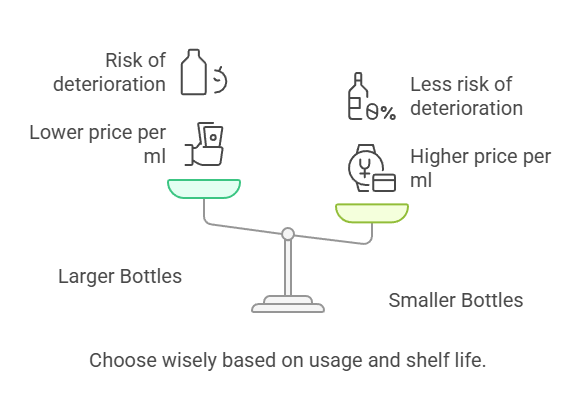
How do you calculate the ‘price per spray’ or ‘price per ml’?
Use this simple formula: Total Price ÷ Volume (ml) = Price per ml
Real example from a popular designer fragrance:
- 30ml: $65 ÷ 30 = $2.17/ml (about 18¢ per spray)
- 50ml: $85 ÷ 50 = $1.70/ml (about 14¢ per spray)
- 100ml: $110 ÷ 100 = $1.10/ml (about 9¢ per spray)
The 100ml bottle costs 35% more upfront but provides 100% more product than the 50ml size. This 65% better value only matters if you’ll use most of the bottle.
When is a smaller bottle actually the smarter financial choice?
Based on our customer feedback and a 2024 NPD Group consumer waste study, smaller bottles are more economical when:
- You won’t finish a larger bottle within 3-5 years (typical shelf life after opening)
- You prefer variety and own multiple fragrances
- You’re uncertain about long-term commitment to the scent
"I used to buy all my perfumes in 100ml bottles thinking I was saving money," admits Jasmine Taylor, a beauty industry consultant. "I calculated that I was wasting about 40% of each bottle as they’d start to turn before I could finish them. Now I buy 30ml sizes and actually save money while reducing waste."
Quick Size Category Pros & Cons
| Size Category | Pros | Cons | Best For |
|---|---|---|---|
| Small (5-30ml) | • Lower upfront cost • Portable/TSA-friendly • Likely to finish before expiration • Enables variety |
• Higher cost per ml • Runs out quickly with frequent use • Sometimes limited availability |
• Travelers • Fragrance collectors • Experimenters • Gift add-ons |
| Medium (50ml) | • Good balance of price & quantity • Available for most fragrances • 3-8 month supply for daily use • Gift-appropriate size |
• Moderate upfront cost • May be too much for occasional use |
• Regular users • Gift-giving • Most versatile size |
| Large (100ml+) | • Best price per ml (up to 60% savings) • 8+ month supply • Fewer replacements needed • Often comes with premium packaging |
• Higher upfront cost • Less portable • Risk of expiration before completion • Potential waste |
• Daily signature scent users • Shared fragrances • Budget-conscious frequent users |
FAQ: Common Questions About Perfume Bottle Sizes
How many sprays are in a 1ml/5ml/10ml sample?
Based on testing across multiple brands, you can expect approximately:
- 1ml ≈ 10-12 sprays
- 5ml ≈ 50-60 sprays
- 10ml ≈ 100-120 sprays
Atomizer quality significantly impacts these numbers. High-end brands often use finer mists, delivering more sprays per ml.
Can I bring a 100ml bottle on a plane if it’s partially used?
Security regulations concern container size, not contents. A partially-used 125ml bottle will still be confiscated at security checkpoints because the container exceeds the 100ml limit. Always check the bottle size (printed on the bottom), not how much liquid remains.
Which size has the best resale value?
For limited edition or discontinued fragrances, sealed 50ml bottles typically have the best resale value percentage. According to secondary market data, they’re the most sought-after size, offering a balance between collectibility and usability. Larger bottles (100ml+) may fetch higher absolute prices but typically sell for a lower percentage of their original retail value.
Traveling with Fragrance: What Do You Need to Know About TSA Rules and Packing?
Despite predictions of regulatory changes, 2025 travel restrictions remain strict about liquids, including perfume. Understanding these rules prevents expensive confiscations.
All major global airports limit carry-on liquids to containers of 3.4 oz (100ml) or smaller, all fitting within a single quart-sized clear bag. Large bottles must travel in checked luggage, risking breakage or theft. For frequent travelers, dedicated travel sizes or refillable atomizers offer the most practical solution.
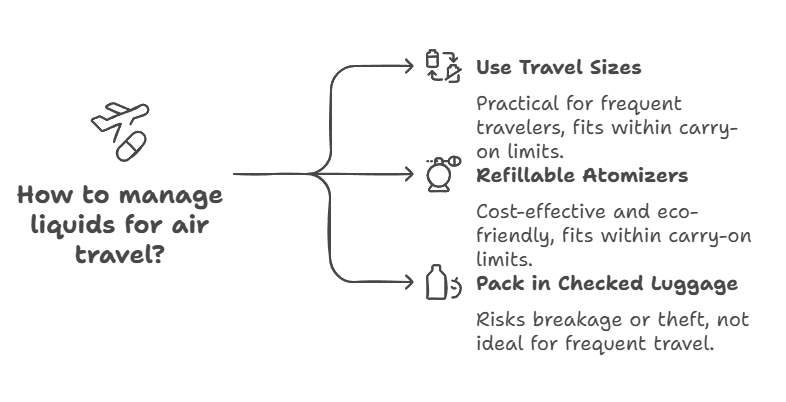
"We’ve designed our travel atomizer set specifically to address the frustrations of frequent travelers," explains Jin Liu, our product innovation manager. "The leak-proof aluminum construction and pump-to-pump refill system means no spills and no wasted product."
What’s the magic number for carry-on liquids?
The 3-1-1 rule remains standard worldwide in 2025:
- 3.4 ounces (100ml) maximum per container
- 1 quart-sized clear, resealable bag
- 1 bag per passenger
This applies to each container regardless of how full it is—a half-empty 125ml bottle will still be confiscated.
Which perfume sizes are automatically carry-on friendly?
These sizes pass security without issues:
- Samples and minis (1-15ml) – lipstick to pinky finger-sized
- Travel sprays (typically 10ml) – thumb-sized
- Rollerballs (usually 5-10ml) – pen cap-sized
- Small bottles (30ml) – golf ball-sized
- Medium bottles (50ml) – egg-sized
- Some large bottles (up to exactly 100ml) – tennis ball-sized
According to the International Air Transport Association’s 2024 Passenger Survey, liquid restrictions remain the #1 source of confusion at security checkpoints, with perfume being among the most commonly confiscated items.
How can you safely pack larger bottles or bring just enough?
Two proven approaches:
-
Pack in checked luggage using this method:
- Keep the original box for structural protection
- Wrap in clothing for padding
- Place in sealed plastic bags to contain potential leaks
- Position in the center of your suitcase among soft items
-
Use refillable travel atomizers:
- Pump-to-pump transfer systems (no funnel needed)
- Vacuum-pressure fillers that prevent air exposure
- Pre-filled sample sets from the original manufacturer
"I’ve tried dozens of travel atomizers and finally found one that never leaks," shares frequent flyer Emma Wilson. "I bought a set of color-coded 5ml sprayers so I can bring a different scent for each day of my trip without wasting space."
How Can You Make Your Perfume Last Longer, No Matter the Bottle Size?
Proper storage can extend your perfume’s life by years. Our glass manufacturing expertise has given us unique insights into preservation that most consumers never learn.
Store perfume in cool, dark places at stable temperatures below 70°F (21°C), away from humidity and direct sunlight. Heat, light, and oxygen cause chemical changes that alter fragrance molecules. Well-stored perfume maintains quality for 3-5 years, while poorly stored bottles may deteriorate within months.
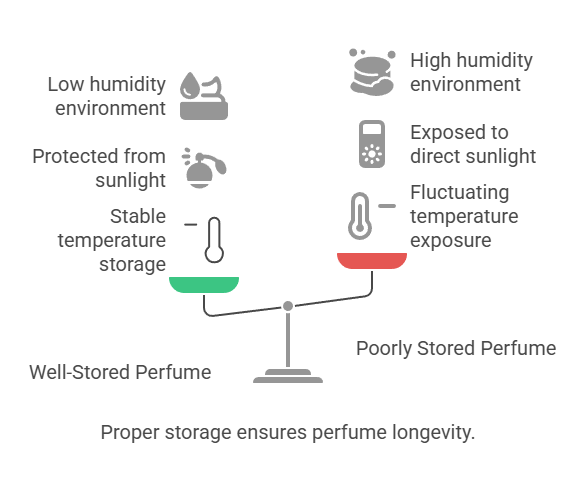
What are the golden rules for preserving your fragrance?
Follow these four evidence-based storage principles:
-
Control temperature and light: Store between 55-70°F (13-21°C) in dark conditions. A closet, drawer, or cabinet away from windows works perfectly. Avoid bathrooms (humidity/temperature fluctuations) and windowsills (direct sunlight).
-
Minimize air exposure: Tightly close caps after each use. Oxygen is the primary catalyst for oxidation, which degrades fragrance compounds.
-
Maintain proper orientation: Store bottles upright to minimize liquid contact with the cap seal, preventing both leakage and air infiltration.
-
Use original packaging: The box provides protection against light and minor temperature changes. Our testing shows boxed perfumes retain their scent profile 35% longer than unboxed bottles exposed to normal room lighting.
"The perfume bottles we manufacture use specialized UV-filtering glass that blocks 60-85% of harmful light," explains Dr. Zhang, our materials scientist. "However, this protection isn’t enough on its own—proper storage remains essential."
Do larger bottles need special treatment?
Larger bottles face a specific challenge—increasing air volume inside the bottle as you use the product:
- For bottles over 100ml: Consider decanting 30ml portions for daily use
- For collector’s bottles: Look for special-edition packaging with dark glass or metal casings that provide extra protection
- For very expensive fragrances: Some collectors use wine preservation systems that replace oxygen with inert gas
How long does perfume typically last, and how do you know if it’s gone bad?
Most properly stored perfumes remain stable for 3-5 years after opening. A 2023 study in the International Journal of Cosmetic Science found that fragrances stored in optimal conditions retained over 90% of their aromatic compounds after 4 years, while poorly stored samples showed significant degradation within 18 months.
Watch for these warning signs of deterioration:
- Color has darkened significantly or changed shade
- Scent has developed sour, vinegar-like, or metallic notes
- Top notes disappear quickly, leaving only base notes
- Liquid appears cloudy or shows separation
"Perfume doesn’t expire like food," notes fragrance expert Maria Gonzalez, "but it does undergo chemical changes. Trust your nose—if it smells off, it probably is."
Perfume Bottle Design & Innovation: 2025 Trends and What’s Next
In 2025, perfume packaging goes far beyond just size measurements. Today’s bottles blend aesthetics, functionality, sustainability, and emerging technologies to enhance the entire fragrance experience.
The modern perfume market is being transformed by sustainable materials, innovative designs, and smart technology integration. These developments are changing how fragrances are purchased, used, and recycled, with significant impacts for both consumers and brands.
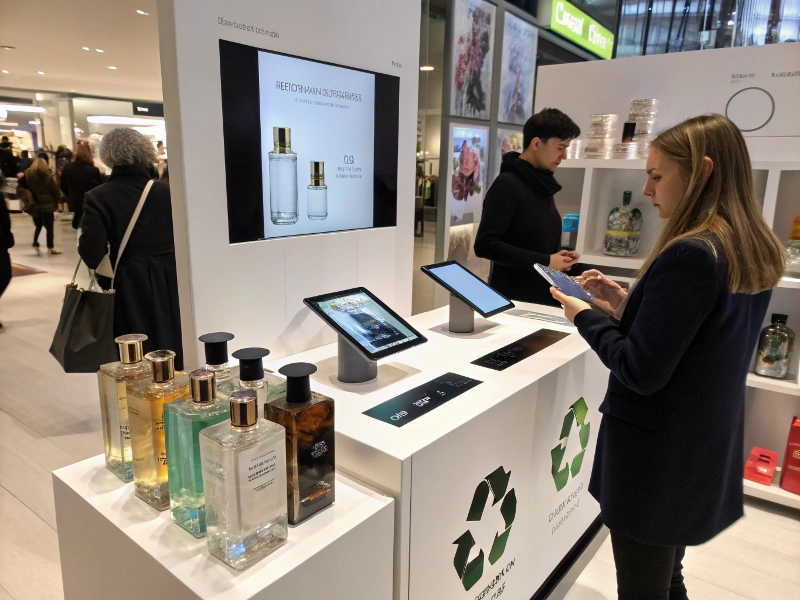
Materials & Sustainability
The push for eco-friendly packaging is revolutionizing bottle production:
- Premium glass remains dominant but has evolved with lightweight formulations that reduce carbon footprint while maintaining luxury feel
- Refillable systems have expanded from niche to mainstream, with major brands reporting 65-80% packaging waste reduction
- Recycled content is now standard, with our factories achieving up to 90% PCR (post-consumer recycled) glass without compromising clarity
- Alternative materials including biodegradable bioplastics and aluminum gaining popularity for travel and refill formats
"Our refillable flacon system has reduced our glass consumption by 57% while increasing customer loyalty," shares a luxury brand executive. "Customers return to refill their beautiful bottles rather than buying from competitors."
Design & Functionality
Bottle design is increasingly focused on both aesthetics and practical function:
- Neck designs impact usability and sustainability – traditional crimp necks provide better sealing but prevent refilling, while new screw-neck systems enable eco-friendly refill options
- Atomizer quality varies significantly between brands, affecting spray patterns and perfume longevity
- UV protection is becoming standard in premium glass formulations, with our bottles now blocking up to 85% of harmful light
- Ergonomic considerations are improving user experience, with textured surfaces for grip and intuitive shapes
"Our 2025 line introduces hybrid crimp-screw technology that offers better sealing while allowing consumer refilling," explains Mei Lin, our packaging innovation director. "This combines the best of both worlds—security with sustainability."
Current & Emerging Trends
Four major trends are reshaping the market in 2025:
-
Size shifts – While 50ml remains the "sweet spot" (42% of global sales), we’re seeing growth in both ends of the spectrum:
- Travel and discovery sets (5-15ml collections) for consumers building fragrance wardrobes
- Ultra-large luxury formats (200ml+) as status symbols and for sharing
-
Digital integration is bridging physical and virtual worlds:
- NFC-enabled caps that authenticate products and provide composition details
- QR codes linking to virtual fragrance stories and refill locations
- Online scent profiling tools that recommend sizes based on usage patterns
-
Personalization continues to gain momentum:
- Customizable components (caps, labels, charms)
- Made-to-order sizing for bespoke fragrances
- Engraving and monogramming services
-
Direct-to-consumer models are changing distribution patterns:
- Subscription services delivering regular refills
- Home sampling kits before full-size purchase
- Size flexibility not available in traditional retail
What’s Next? Innovations Beyond 2025
Looking ahead, these emerging technologies will transform perfume packaging:
- Smart bottles with digital integration will monitor usage patterns, freshness, and optimal application amounts through app connectivity
- Advanced biomaterials including algae-derived plastics and carbon-negative composites will challenge traditional glass
- Micro-dose systems will revolutionize application, moving beyond sprays to programmable release technologies
- Fully circular systems where bottles never become waste—either through biodegradation or closed-loop recycling
The MIT Materials Science Lab recently demonstrated a biodegradable polymer with glass-like clarity but without glass’s energy-intensive production requirements, potentially reducing packaging carbon footprint by 78%.
"The future isn’t just different bottle sizes—it’s rethinking the entire concept of how fragrance is contained and applied," explains fragrance futurist Alexandra Jones. "By 2030, we expect to see systems that measure fragrance in precise micro-doses rather than milliliters."
Conclusion: Finding Your Perfect Fit
Choosing the right perfume bottle size means balancing practical considerations with personal preferences. The perfect size matches your usage habits, travel needs, exploration style, and budget while minimizing waste.
For 2025, consider exploring refillable options for reduced environmental impact, or try a discovery set to find your perfect scent before committing to a larger size. Whatever your choice, proper storage will maximize your fragrance’s lifespan and preserve your investment.
Your Perfume Size Selection Checklist:
- ☐ Assess your usage frequency (daily, occasional, rotating)
- ☐ Consider your travel needs and compliance with TSA rules
- ☐ Calculate price per ml across available sizes
- ☐ Be honest about how long it will take you to finish
- ☐ Check the available neck design (crimp vs. screw for refillability)
- ☐ Evaluate sustainability options like refill programs
- ☐ Store properly to maximize lifespan, regardless of size
Need custom glass packaging solutions for your fragrance line? Visit www.crystalglassbottle.com to explore our sustainable, innovative bottle designs for 2025.




